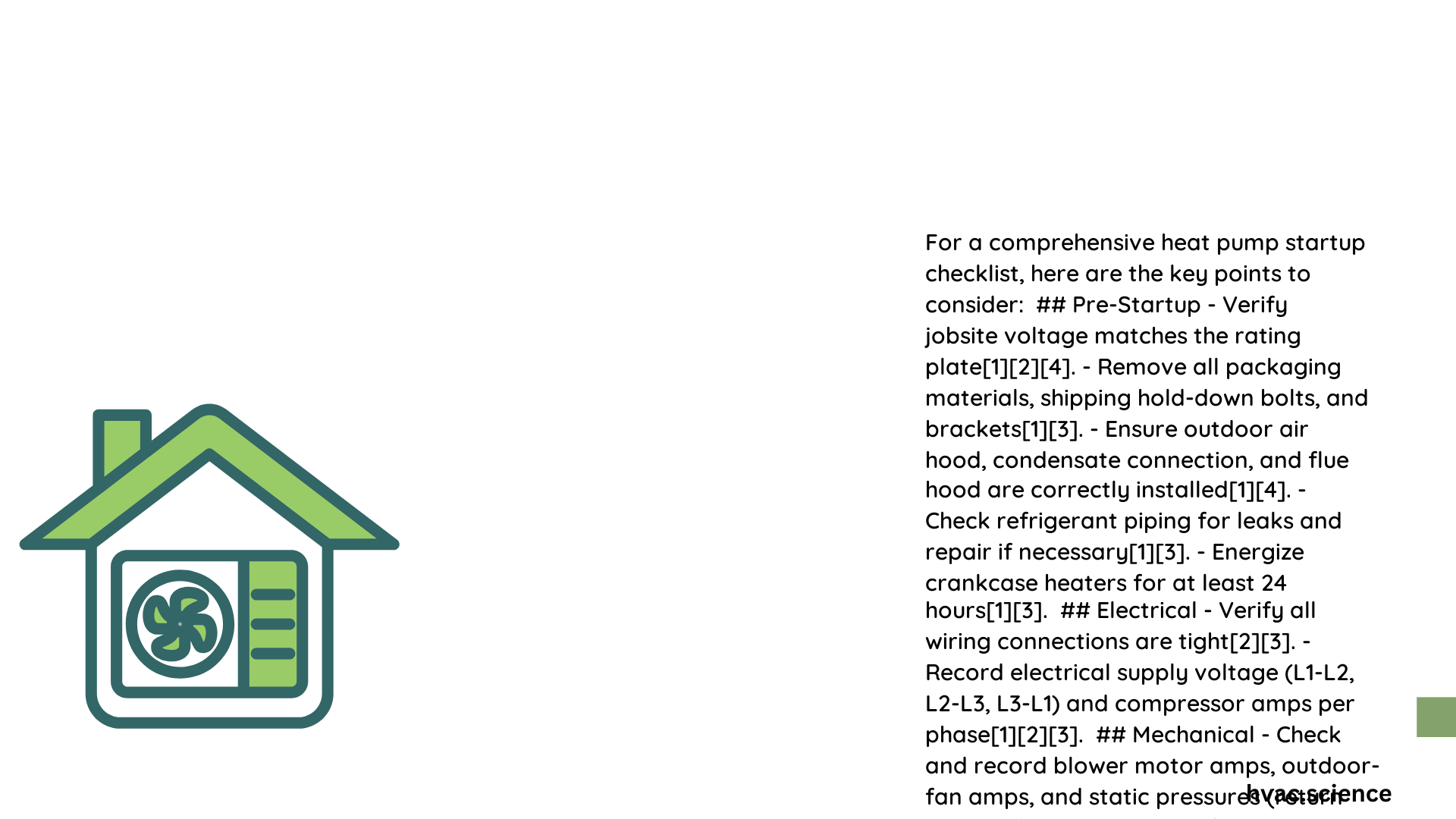A comprehensive heat pump startup checklist is crucial for ensuring optimal system performance, energy efficiency, and longevity. This guide provides technicians and homeowners with a systematic approach to verifying electrical connections, refrigerant levels, system settings, and critical pre-startup checks that prevent potential operational issues and maximize equipment reliability.
What Are the Essential Pre-Startup Verification Steps?
Electrical System Preparation
Before initiating heat pump startup, technicians must conduct thorough electrical system assessments:
| Verification Parameter | Critical Checks | Acceptable Range |
|---|---|---|
| Jobsite Voltage | Measure L1-L2, L2-L3, L3-L1 voltages | ±10% of rating plate specification |
| Connection Integrity | Terminal tightness | No loose connections |
| Grounding | Proper electrical ground | Meets local electrical codes |
Voltage Verification Procedure
- Use calibrated multimeter
- Compare measured voltage with unit’s rating plate
- Document voltage readings
- Verify three-phase balance
Refrigerant System Inspection
Key Refrigerant Evaluation Criteria:
– Check piping for potential leaks
– Verify refrigerant charge using manufacturer’s charging charts
– Inspect refrigerant line insulation
– Confirm proper pipe routing and support
Critical Component Preparation
Before startup, ensure:
– All packaging materials are completely removed
– Outdoor air hood is correctly installed
– Condensate connections are properly secured
– Crankcase heaters energized for minimum 24 hours
How to Perform Initial System Startup?

Cooling Mode Activation
When initiating cooling mode:
– Close Y1 terminal
– Observe compressor rotation
– Monitor outdoor fan motor ramp-up
– Check condenser coil warming sequence
Performance Measurement Protocol
Record comprehensive operational data:
– Electrical supply voltage
– Compressor amperage (L1, L2, L3)
– Indoor/outdoor fan amperage
– Blower wheel RPM
– Static pressure readings
Temperature Monitoring
Critical temperature measurements include:
– Outdoor air temperature (dry bulb/wet bulb)
– Return air temperature
– Supply air temperature
– Gas heat supply air temperature (if applicable)
What Are Common Startup Challenges?
Potential Startup Issues
- Voltage Inconsistencies
- Symptom: Erratic system performance
-
Solution: Verify and stabilize electrical supply
-
Refrigerant Charge Problems
- Symptom: Reduced cooling/heating efficiency
-
Solution: Precise refrigerant level adjustment
-
Electrical Connection Failures
- Symptom: Intermittent operation
- Solution: Comprehensive connection inspection
Recommended Tools for Startup
| Tool Category | Specific Tools | Purpose |
|---|---|---|
| Electrical | Multimeter | Voltage/amperage verification |
| Refrigeration | Manifold gauge set | Refrigerant pressure checking |
| Measurement | Thermometers | Temperature differential assessment |
| Safety | Personal protective equipment | Technician protection |
Best Practices for Successful Startup
- Always follow manufacturer’s specific guidelines
- Document all measurements and observations
- Perform systematic, methodical checks
- Prioritize safety throughout the process
Professional Recommendations
- Conduct annual professional maintenance
- Keep detailed service records
- Train personnel on proper startup procedures
- Stay updated with manufacturer’s latest guidelines
Reference:
– HVAC Manufacturer Startup Guidelines
– ENERGY STAR HVAC Maintenance Resources
– Professional HVAC Technician Association
